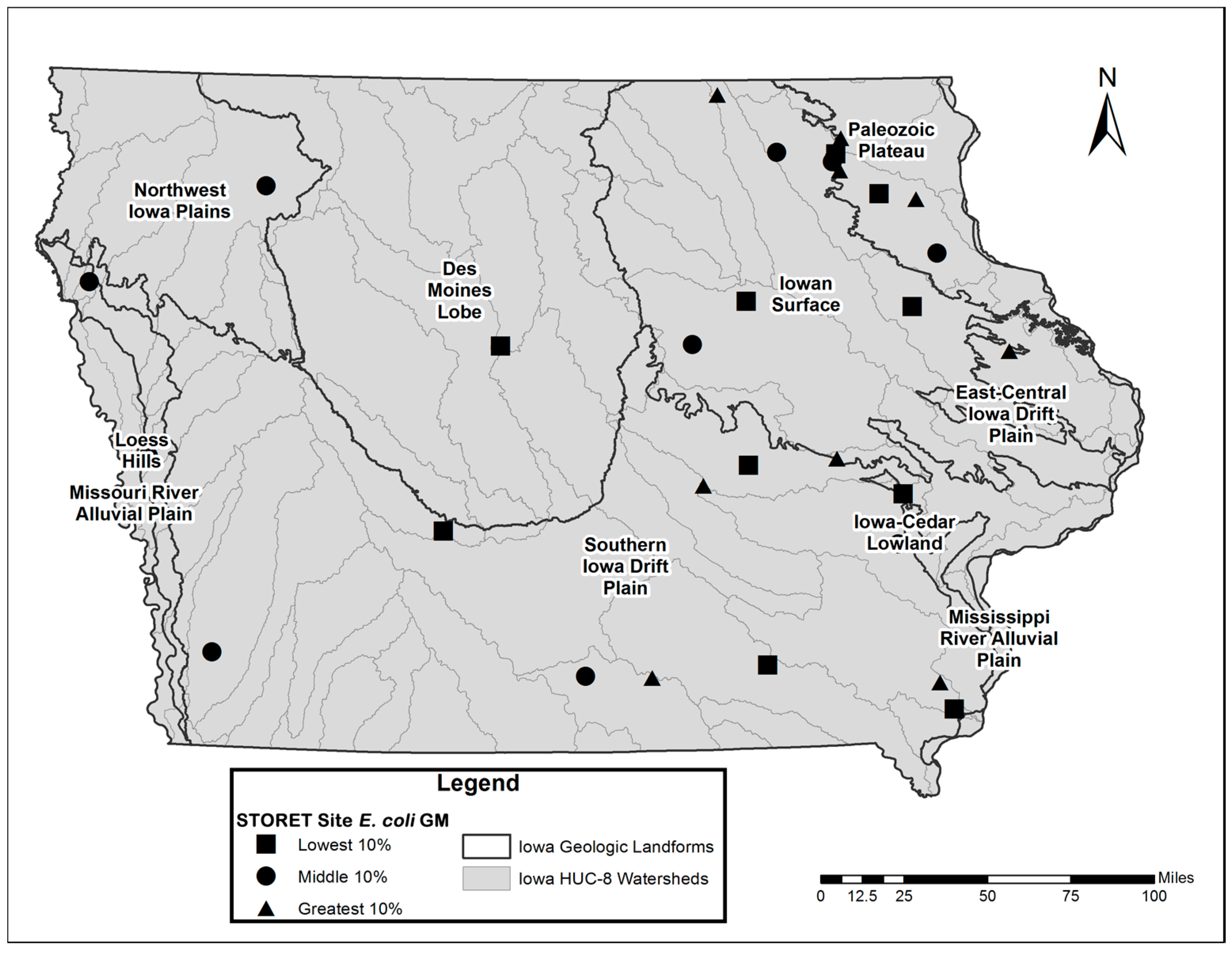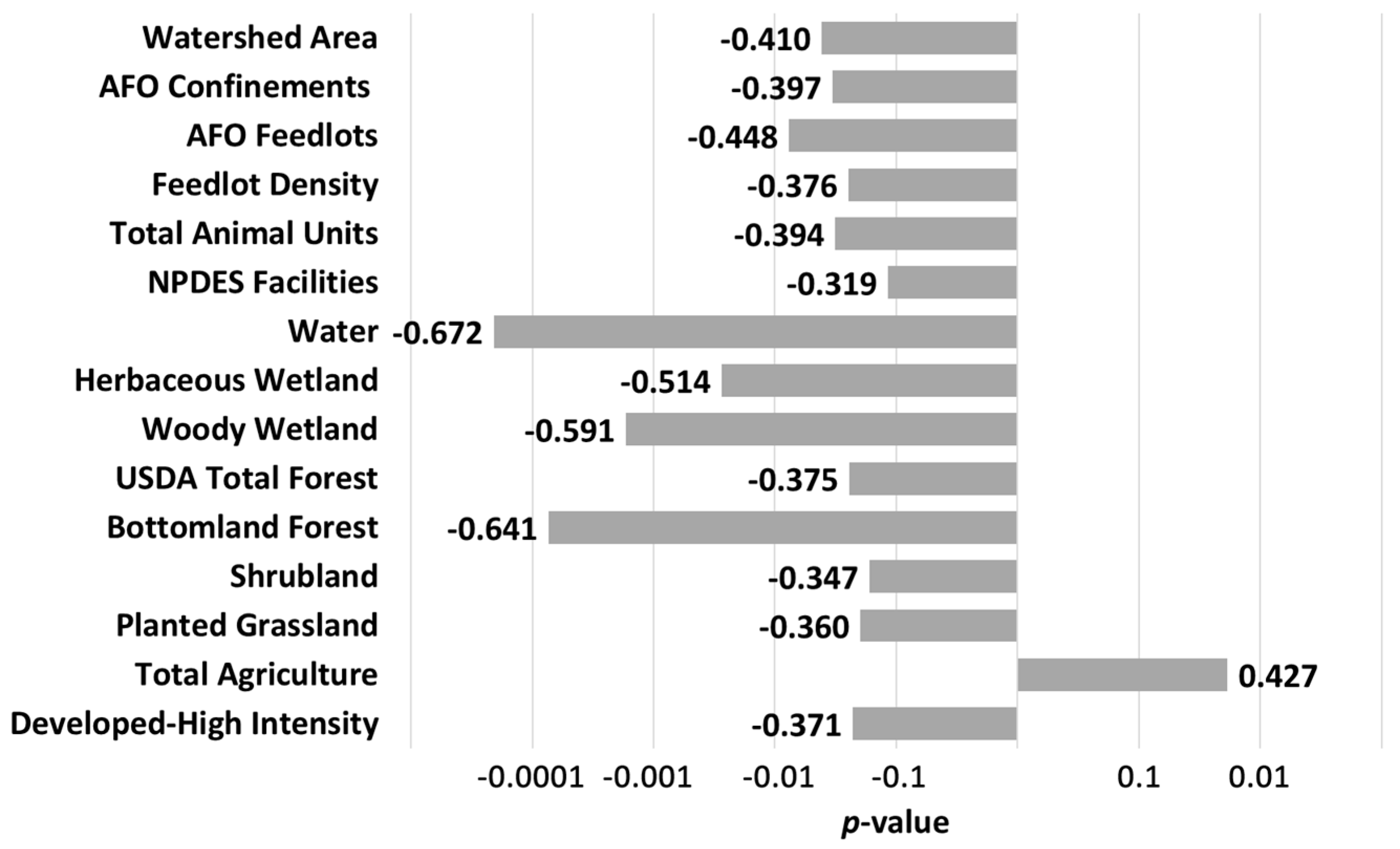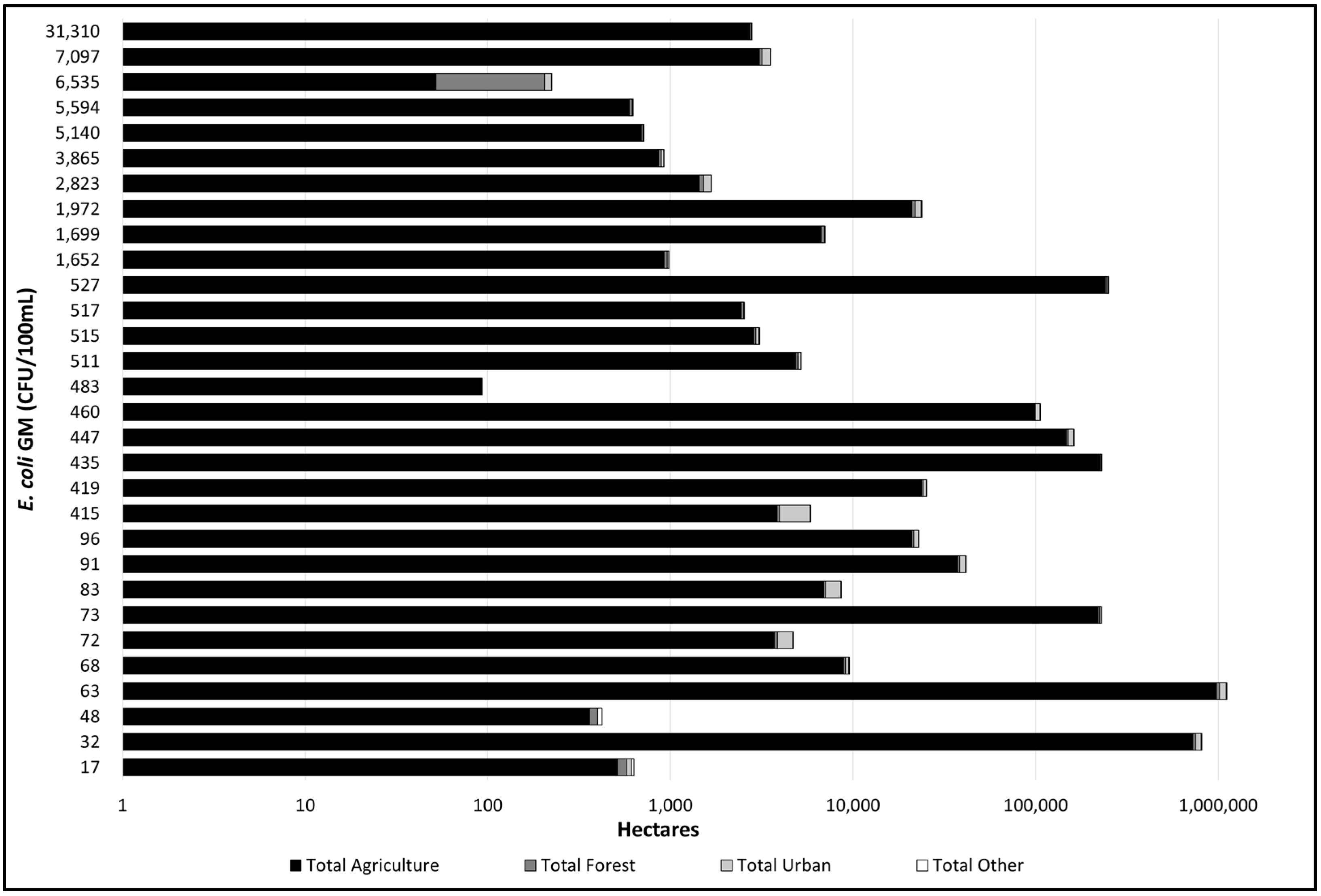Relating Watershed Characteristics to Elevated Stream Escherichia coli Levels in Agriculturally Dominated Landscapes: An Iowa Case Study
Abstract
:1. Introduction
2. Materials and Methods
2.1. Watershed Delineation
2.2. GIS Data
2.3. Analysis
3. Results and Discussion
3.1. Watershed Area
3.2. AFOs and Manure Application
3.3. Point-Sources
3.4. Land Cover
3.4.1. Water/Wetland
3.4.2. Forest
3.4.3. Shrubland
3.4.4. Grassland
3.4.5. Crops
3.4.6. Barren
3.4.7. Total Agriculture
3.4.8. Total Urban/Developed
3.5. Multiple Regression Model
4. Conclusions
Supplementary Materials
Acknowledgments
Author Contributions
References
- Crowther, J.; Kay, D.; Wyer, M.D. Faecal-indicator concentrations in waters draining lowland pastoral catchments in the UK: Relationships with land use and farming practices. Water Res. 2002, 36, 1725–1734. [Google Scholar] [CrossRef]
- Thurston-Enriquez, J.A.; Gilley, J.E.; Eghball, B. Microbial quality of runoff following land application of cattle manure and swine slurry. J. Water Health 2005, 3, 157–171. [Google Scholar] [PubMed]
- Soupir, M.; Mostaghimi, S.; Yagow, E.; Hagedorn, C.; Vaughan, D. Transport of fecal bacteria from poultry litter and cattle manures applied to pastureland. Water Air Soil Pollut. 2006, 169, 125–136. [Google Scholar] [CrossRef]
- Burkholder, J.; Libra, B.; Weyer, P.; Heathcote, S.; Kolpin, D.; Thome, P.S.; Wichman, M. Impacts of waste from concentrated animal feeding operations on water quality. Environ. Health Perspect. 2007, 115, 308–312. [Google Scholar] [CrossRef] [PubMed]
- Graves, A.K.; Hagedorn, C.; Teetor, A.; Mahal, M.; Booth, A.M.; Reneau, R.B. Antibiotic resistance profiles to determine sources of fecal contamination in a rural Virginia watershed. J. Environ. Qual. 2002, 31, 1300–1308. [Google Scholar] [CrossRef] [PubMed]
- Whitlock, J.E.; Jones, D.T.; Harwood, V.J. Identification of the sources of fecal coliforms in an urban watershed using antibiotic resistance analysis. Water Res. 2002, 36, 4273–4282. [Google Scholar] [CrossRef]
- Somarelli, J.; Makarewicz, J.; Sia, R.; Simon, R. Wildlife identified as major source of Escherichia coli in agriculturally dominated watersheds by BOX A1R-derived genetic fingerprints. J. Environ. Manag. 2007, 82, 60–65. [Google Scholar] [CrossRef] [PubMed]
- Fujioka, R.; Sian-Denton, C.; Borja, M.; Castro, J.; Morphew, K. Soil: The environmental source of Escherichia coli and enterococci in Guam’s streams. J. Appl. Microbiol. 1998, 85, 83S–89S. [Google Scholar] [CrossRef] [PubMed]
- Guardabassi, L.; Wong, D.M.L.F.; Dalsgaard, A. The effects of tertiary wastewater treatment on the prevalence of antimicrobial resistant bacteria. Water Res. 2002, 36, 1955–1964. [Google Scholar] [CrossRef]
- Kay, D.; Crowther, J.; Stapleton, C.M.; Wyer, M.D.; Fewtrell, L.; Edwards, A.; Francis, C.; McDonald, A.T.; Watkins, J.; Wilkinson, J. Faecal indicator organism concentrations in sewage and treated effluents. Water Res. 2008, 42, 442–454. [Google Scholar] [CrossRef] [PubMed]
- Anastasi, E.; Matthews, B.; Gundogdu, A.; Vollmerhausen, T.; Ramos, N.; Stratton, H.; Ahmed, W.; Katouli, M. Prevalence and persistence of Escherichia coli strains with uropathogenic virulence characteristics in sewage treatment plants. Appl. Environ. Microbiol. 2010, 76, 5882–5886. [Google Scholar] [CrossRef] [PubMed]
- Anastasi, E.; Matthews, B.; Stratton, H.M.; Katouli, M. Pathogenic Escherichia coli found in sewage treatment plants and environmental waters. Appl. Environ. Microbiol. 2012, 78, 5536–5541. [Google Scholar] [CrossRef] [PubMed]
- Webster, L.F.; Thompson, B.C.; Fulton, M.H.; Chestnut, D.E.; Van Dolah, R.F.; Leight, A.K.; Scott, G.I. Identification of sources of Escherichia coli in South Carolina estuaries using antibiotic resistance analysis. J. Exp. Mar. Biol. Ecol. 2004, 298, 179–195. [Google Scholar] [CrossRef]
- United States Environmental Protection Agency (US EPA). National Water Quality Inventory: Report to Congress; Technical Report; US EPA: Washington, DC, USA, 2009.
- Iowa Department of Natural Resources (IDNR). Understanding Iowa’s Impaired Waters. Available online: http://www.iowadnr.gov/Portals/idnr/uploads/water/watershed/files/impairedwaters2015.pdf (accessed on 10 September 2016).
- United States Environmental Protection Agency (US EPA). 2012 Recreational Water Quality Criteria. 2012. Available online: https://www.epa.gov/sites/production/files/2015-10/documents/rwqc2012.pdf (accessed on 18 February 2016). [Google Scholar]
- Jamieson, R.; Gordon, R.; Joy, D.; Lee, H. Assessing microbial pollution of rural surface waters: A review of current watershed scale modeling approaches. Agric. Water Manag. 2004, 70, 1–17. [Google Scholar] [CrossRef]
- Baffaut, C.; Sadeghi, A. Bacteria modeling with SWAT for assessment and remediation studies: A review. Trans. ASABE 2010, 53, 1585–1594. [Google Scholar] [CrossRef]
- Sliva, L.; Williams, D.D. Buffer zone versus whole catchment approaches to studying land use impact on river water quality. Water Res. 2001, 35, 3462–3472. [Google Scholar] [CrossRef]
- Tong, S.T.; Chen, W. Modeling the relationship between land use and surface water quality. J. Environ. Manag. 2002, 66, 377–393. [Google Scholar] [CrossRef]
- Pandey, P.K.; Soupir, M.L.; Haddad, M.; Rothwell, J.J. Assessing the impacts of watershed indexes and precipitation on spatial in-stream E. coli concentrations. Ecol. Indic. 2012, 23, 641–652. [Google Scholar] [CrossRef]
- Green, R.H. Sampling Design and Statistical Methods for Environmental Biologists; John Wiley & Sons: New York, NY, USA, 1979. [Google Scholar]
- MacCallum, R.C.; Browne, M.W.; Sugawara, H.M. Power analysis and determination of sample size for covariance structure modeling. Psychol. Method. 1996, 1, 130. [Google Scholar] [CrossRef]
- Garnier, J.; Servais, P.; Billen, G. Bacterioplankton in the Seine River (France): Impact of the Parisian urban effluent. Can. J. Microbiol. Rev. Can. Microbiol. 1992, 38, 56–64. [Google Scholar] [CrossRef]
- Hoch, B.; Berger, B.; Kavka, G.; Herndl, G.J. Influence of wastewater treatment on the microbial ecology of a large, temperate river system—The Danube River. Hydrobiologia 1996, 321, 205–218. [Google Scholar] [CrossRef]
- Gollehon, N.; Caswell, M.; Ribaudo, M.; Kellogg, R.; Lander, C.; Letson, D. Confined Animal Production and Manure Nutrients. Agriculture Information Bulletin No. 771, Resources Economics Division. 2001. Available online: http://www.ers.usda.gov/publications/aib771/aib771.pdf (accessed on 21 February 2017).
- Iowa Agriculture Literacy Foundation (IALF). A Look at Iowa Agriculture. Available online: http://www.agclassroom.org/teacher/stats/iowa.pdf (accessed on 20 December 2015).
- ArcGIS Desktop, Version 10.2.2; Environmental Systems Research Institute (ESRI): Redlands, CA, USA, 2014.
- ArcSWAT, Version 2012.10.18; United States Department of Agriculture-Agricultural Research Service (USDA-ARS): Temple, TX, USA, 2012.
- Iowa Department of Natural Resources (IDNR). Iowa DNR Animal Feeding Operatoin. Available online: https://programs.iowadnr.gov/animalfeedingoperations/ (accessed on 30 September 2016).
- Iowa Department of Natural Resources (IDNR). Animal Feeding Operations. Available online: http://www.iowadnr.gov/Environmental-Protection/Land-Quality/Animal-Feeding-Operations (accessed on 30 September 2016).
- JMP Pro, Version 12.1.0; SAS Institute: Cary, NC, USA, 2015.
- Hair, J.F.; Anderson, R.E.; Babin, B.J.; Black, W.C. Multivariate Data Analysis: A Global Perspective; Pearson: Upper Saddle River, NJ, USA, 2010; Volume 7. [Google Scholar]
- Kennedy, P. A Guide to Econometrics; The MIT Press: Cambridge, MA, USA, 1992. [Google Scholar]
- Marquaridt, D.W. Generalized inverses, ridge regression, biased linear estimation, and nonlinear estimation. Technometrics 1970, 12, 591–612. [Google Scholar] [CrossRef]
- Neter, J.; Wasserman, W.; Kutner, M.H. Applied Linear Regression Models; Richard D. Irwin Inc.: Homewood, IL, USA, 1983. [Google Scholar]
- Harmel, R.; Karthikeyan, R.; Gentry, T.; Srinivasan, R. Effects of agricultural management, land use, and watershed scale on E. coli concentrations in runoff and streamflow. Trans. ASABE 2010, 53, 1833–1841. [Google Scholar] [CrossRef]
- Butler, R.; Orlob, G.; McGauhey, P. Underground movement of bacterial and chemical pollutants. J. Am. Water Works Assoc. 1954, 46, 97–111. [Google Scholar]
- Bai, S.; Lung, W.-S. Modeling sediment impact on the transport of fecal bacteria. Water Res. 2005, 39, 5232–5240. [Google Scholar] [CrossRef] [PubMed]
- Oliver, D.M.; Clegg, C.D.; Heathwaite, A.L.; Haygarth, P.M. Preferential attachment of Escherichia coli to different particle size fractions of an agricultural grassland soil. Water Air Soil Pollut. 2007, 185, 369–375. [Google Scholar] [CrossRef] [Green Version]
- Schultz-Fademrecht, C.; Wichern, M.; Horn, H. The impact of sunlight on inactivation of indicator microorganisms both in river water and benthic biofilms. Water Res. 2008, 42, 4771–4779. [Google Scholar] [CrossRef] [PubMed]
- Tian, Y.Q.; Gong, P.; Radke, J.D.; Scarborough, J. Spatial and temporal modeling of microbial contaminants on grazing farmlands. J. Environ. Qual. 2002, 31, 860–869. [Google Scholar] [CrossRef] [PubMed]
- Brater, E.F. The unit hydrograph principle applied to small watersheds. Am. Soc. Civ. Eng. 1940, 195, 1154–1178. [Google Scholar]
- Cleland, B.R. TMDL Development from the “bottom up”—Part III: Duration Curves and wet-weather assessments. Proc. Water Environ. Fed. 2003, 2003, 1740–1766. [Google Scholar] [CrossRef]
- Mishra, A.; Benham, B.L.; Mostaghimi, S. Bacterial transport from agricultural lands fertilized with animal manure. Water Air Soil Pollut. 2008, 189, 127–134. [Google Scholar] [CrossRef]
- Hruby, C.; Soupir, M.; Moorman, T.; Shelley, M.; Kanwar, R. Effects of tillage and poultry manure application rates on Salmonella and fecal indicator bacteria concentrations in tiles draining Des Moines Lobe soils. J. Environ. Manag. 2016, 171, 60–69. [Google Scholar] [CrossRef] [PubMed]
- Iowa Department of Natural Resources (IDNR). NPDES Wastewater Permitting. Available online: http://www.iowadnr.gov/Environmental-Protection/Water-Quality/NPDES-Wastewater-Permitting (accessed on 17 March 2016).
- Hyland, R.; Byrne, J.; Selinger, B.; Graham, T.; Thomas, J.; Townshend, I.; Gannon, V. Spatial and temporal distribution of fecal indicator bacteria within the Oldman River basin of southern Alberta, Canada. Water Qual. Res. J. Can. 2003, 38, 15–32. [Google Scholar]
- Neralla, S.; Weaver, R.W.; Lesikar, B.J.; Persyn, R.A. Improvement of domestic wastewater quality by subsurface flow constructed wetlands. Bioresour. Technol. 2000, 75, 19–25. [Google Scholar] [CrossRef]
- Ibekwe, A.M.; Grieve, C.M.; Lyon, S.R. Characterization of microbial communities and composition in constructed dairy wetland wastewater effluent. Appl. Environ. Microbiol. 2003, 69, 5060–5069. [Google Scholar] [CrossRef] [PubMed]
- Decamp, O.; Warren, A. Investigation of Escherichia coli removal in various designs of subsurface flow wetlands used for wastewater treatment. Ecol. Eng. 2000, 14, 293–299. [Google Scholar] [CrossRef]
- Anbumozhi, V.; Radhakrishnan, J.; Yamaji, E. Impact of riparian buffer zones on water quality and associated management considerations. Ecol. Eng. 2005, 24, 517–523. [Google Scholar] [CrossRef]
- Gardi, C. Land use, agronomic management and water quality in a small Northern Italian watershed. Agric. Ecosyst. Environ. 2001, 87, 1–12. [Google Scholar] [CrossRef]
- Li, S.; Gu, S.; Tan, X.; Zhang, Q. Water quality in the upper Han River basin, China: The impacts of land use/land cover in riparian buffer zone. J. Hazard. Mater. 2009, 165, 317–324. [Google Scholar] [CrossRef] [PubMed]
- Mallin, M.A.; Williams, K.E.; Esham, E.C.; Lowe, R.P. Effect of human development on bacteriological water quality in coastal watersheds. Ecol. Appl. 2000, 10, 1047–1056. [Google Scholar] [CrossRef]
- Young, K.D.; Thackston, E.L. Housing density and bacterial loading in urban streams. J. Environ. Eng. 1999, 125, 1177–1180. [Google Scholar] [CrossRef]
- Moriasi, D.; Arnold, J.; Van Liew, M.; Bingner, R.; Harmel, R.; Veith, T. Model evaluation guidelines for systematic quantification of accuracy in watershed simulations. Trans. Asabe 2007, 50, 885–900. [Google Scholar] [CrossRef]




| Layer | Source | Maintenance/Update Frequency | Version |
|---|---|---|---|
| 2006 Iowa Manure Application Areas | Iowa NRGIS Library | Irregular | 2008 Edition, Downloaded in 2014 |
| Iowa AFO Confinements | Iowa NRGIS Library | Monthly | 2013 Edition, Downloaded in 2016 |
| Iowa AFO Feedlots | Iowa NRGIS Library | As Needed | 2012 Edition, Downloaded in 2016 |
| Iowa National Hydrology Dataset (NHD) Flowlines | Iowa NRGIS Library | Irregular | Downloaded in 2014 |
| Iowa NPDES Facilities | Iowa NRGIS Library | Monthly | 2010 Edition, Downloaded in 2016 |
| Iowa STORET monitoring locations | Iowa NRGIS Library | Irregular | 2013 Edition, Downloaded in 2014 |
| 2012 Iowa Cropland Data | USDA National Agricultural Statistics Service | None Planned | 2012 Edition, Downloaded in 2016 |
| National Elevation Dataset (NED) 30-m cells | USDA NRCS Geospatial Data Gateway | None Planned | Downloaded in 2014 |
| 2006 Iowa Manure Application Areas | Iowa NRGIS Library | Irregular | 2008 Edition, Downloaded in 2014 |
| i | Term, xi | Estimate, βi | Std Error | t Ratio | Prob > |t| | VIF |
|---|---|---|---|---|---|---|
| 0 | Intercept | 24,149.022 | 5519.922 | 4.37 | 0.0003 | - |
| 1 | Feedlot Density (#/1000 hectare) | 21,288.786 | 4058.482 | 5.25 | <0.0001 | 6.11 |
| 2 | % Bottomland Forest | 18,079.057 | 7279.138 | 2.48 | 0.0225 | 1.98 |
| 3 | % Shrubland | 11,126.519 | 3246.059 | 3.43 | 0.0028 | 2.15 |
| 4 | # AFO Confinements | 41.705236 | 11.420 | 3.65 | 0.0017 | 7.91 |
| 5 | Total Ag. (USDA Coverage) | −173.2866 | 57.820 | −3.00 | 0.0074 | 1.51 |
| 6 | # AFO Feedlots | −224.3185 | 56.548 | −3.97 | 0.0008 | 9.23 |
| 7 | % Deciduous Forest | −364.5643 | 123.289 | −2.96 | 0.0081 | 1.32 |
| 8 | % Herbaceous Wetlands | −4671.417 | 2444.317 | −1.91 | 0.0712 | 1.55 |
| 9 | % Total Wetland (IDNR Coverage) | −34,966.16 | 6484.586 | −5.39 | <0.0001 | 7.52 |
| 10 | % Evergreen Forest | −166,041.7 | 81,362.020 | −2.04 | 0.0554 | 1.35 |
© 2017 by the authors. Licensee MDPI, Basel, Switzerland. This article is an open access article distributed under the terms and conditions of the Creative Commons Attribution (CC BY) license ( http://creativecommons.org/licenses/by/4.0/).
Share and Cite
Brendel, C.; Soupir, M.L. Relating Watershed Characteristics to Elevated Stream Escherichia coli Levels in Agriculturally Dominated Landscapes: An Iowa Case Study. Water 2017, 9, 154. https://doi.org/10.3390/w9030154
Brendel C, Soupir ML. Relating Watershed Characteristics to Elevated Stream Escherichia coli Levels in Agriculturally Dominated Landscapes: An Iowa Case Study. Water. 2017; 9(3):154. https://doi.org/10.3390/w9030154
Chicago/Turabian StyleBrendel, Conrad, and Michelle L. Soupir. 2017. "Relating Watershed Characteristics to Elevated Stream Escherichia coli Levels in Agriculturally Dominated Landscapes: An Iowa Case Study" Water 9, no. 3: 154. https://doi.org/10.3390/w9030154






